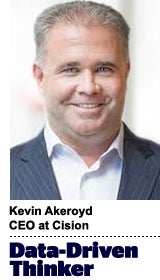 “Data-Driven Thinking” is written by members of the media community and contains fresh ideas on the digital revolution in media.
“Data-Driven Thinking” is written by members of the media community and contains fresh ideas on the digital revolution in media.
Today’s column is written by Kevin Akeroyd, CEO at Cision.
When I first started out in the marketing business, there was no such thing as the cloud. Back then, data-driven marketing involved catalogs, direct mail and Sunday newspaper inserts. It’s hard to believe just how much has changed since then, but the evolution from an analog world to a digital one, where companies can access nearly any kind of marketing tool they can think of, has been an incredible thing to watch – and to be a part of.
In 2013, I took a great opportunity at Oracle to oversee development of its marketing cloud. Oracle CEO Mark Hurd knew then that marketing and ad tech would be a huge category. It was growing faster than any other cloud category, including CRM. Oracle, though, lagged the competition.
Adobe, Salesforce and others were building their marketing clouds in earnest. In 2009, Adobe bought web analytics company Omniture for $1.8 billion, and it ended up making seven more acquisitions and is still going.
In 2011, Salesforce bought social media monitoring company Radian 6, and quickly followed with its $689 million acquisition of Buddy Media in 2012 and a $2.5 billion blockbuster acquisition of ExactTarget in 2013. Both made several other game-changing acquisitions.
At Oracle, we got busy fast. I oversaw the purchase and integration of nine companies, deploying more than $6 billion in capital. By the time I left in 2016, the company was one of the leaders in the marketing cloud space. Our thesis was right: Demand for these kinds of tools, from social media monitoring to digital marketing automation and website analytics, was expanding exponentially.
As importantly, the CMO didn’t want to continue to buy non-integrated point solutions across channels, life cycle stages or each part of the workflow. They wanted an all-inclusive “stack” that allowed all of this to be enabled with one strategic tech, data and measurement platform and one strategic vendor or partner.
Marketing clouds are now all-encompassing. They’re robust, mature and broad. Companies can use one cloud and access a plethora of different tools and programs. However, competition among the big software operators is heating up. Each do different things well, but they don’t do everything well, which means these businesses will need to continue making acquisitions or find other ways to fill the holes in their offerings.
Building a bigger cloud
While there are dozens of capabilities in these clouds, there are five mission-critical core competencies in a marketing cloud.
AdExchanger Daily
Get our editors’ roundup delivered to your inbox every weekday.
Daily Roundup
There’s paid media activation, which includes demand-side platforms, such as video, search, search and social.
There’s web and mobile owned properties, which cover content management, analytics, personalization and multivariate testing.
There’s data management, which includes data management platforms.
Fourth is campaign management. In B2B the core solution is marketing automation, and in B2C the old ESPs have been revamped into omnichannel campaign management engines.
Finally, there is data. It includes ownership of third-party data assets, such as Oracle’s Datalogix, integration and onboarding between first-, second- and third-party data and identity resolution, where companies resolve the dozens of social handles, cookies, mobile registration IDs, hashtag emails and many other discrete IDs back into one consumer.
If you think of these marketing clouds as planets, there are also a few related tech categories that exert gravity on these marketing clouds, so I’ll call them moons.
The three biggest and most gravitationally powerful moons to materially influence the choice of marketing clouds – and they are certainly integration priorities once a marketing cloud has been invested in and implemented – are CRM, ecommerce and unified analytics.
Oracle and Salesforce continue to aggressively bundle their marketing and CRM offerings, and it’s no accident that Adobe partners closely with Microsoft on a number of fronts, first and foremost Adobe’s Marketing Cloud and Microsoft’s CRM business unit.
Same with ecommerce. Salesforce and Oracle own their own ecommerce systems and continue to more aggressively integrate and bundle these. And, wow, Adobe just bought ecommerce leader Magento last week for $1.68 billion. That moon is now headed to be part of the core planet.
Adobe has done the best job with unified analytics so far, although all of them still have a long way to go. The cloud business intelligence and analytics vendors, such as Domo and Tableau, have grown their spend in the CMO line of business aggressively given that none of the marketing cloud giants have done a great job satisfying this requirement.
This space continues to see massive growth. The mar tech industry could be a $34 billion business, according to global accounting firm Moore Stephens. With Adobe, Salesforce and Oracle taking nearly 20% of the pie, in my estimation, thousands of companies and a few dozen relevant, at-scale ones are competing for the other 80%.
The “Big 3” are racing to build even bigger and better clouds, and they’ll continue to acquire pieces to enhance the five core competencies. We’ve also seen material entrants from large private equity firms getting into the game, and they will be joined by other very large and acquisitive software companies, so the fun is just beginning here.
All this has been a boon to marketing cloud users. Digital marketing has never been more effective, while integration between programs is getting better all the time. People can now do things far faster with fewer people and resources.
In the past, everything was done in silos. There was a different program for ad buying, marketing automation, audience development, display writing and so on. Now it’s all synced together and integrated into a single workflow.
Follow Cision (@Cision) and AdExchanger (@adexchanger) on Twitter.












